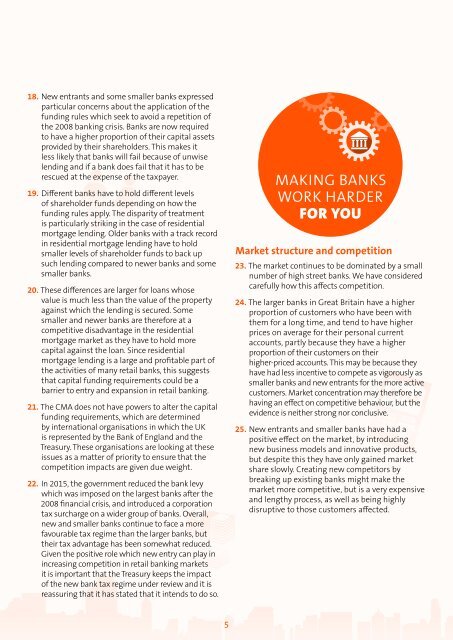Create successful ePaper yourself
Turn your PDF publications into a flip-book with our unique Google optimized e-Paper software.
18.<br />
New entrants and some smaller banks expressed<br />
particular concerns about the application of the<br />
funding rules which seek to avoid a repetition of<br />
the 2008 banking crisis. Banks are now required<br />
to have a higher proportion of their capital assets<br />
provided by their shareholders. This makes it<br />
less likely that banks will fail because of unwise<br />
lending and if a bank does fail that it has to be<br />
rescued at the expense of the taxpayer.<br />
19. Different banks have to hold different levels<br />
of shareholder funds depending on how the<br />
funding rules apply. The disparity of treatment<br />
is particularly striking in the case of residential<br />
mortgage lending. Older banks with a track record<br />
in residential mortgage lending have to hold<br />
smaller levels of shareholder funds to back up<br />
such lending compared to newer banks and some<br />
smaller banks.<br />
20. These differences are larger for loans whose<br />
value is much less than the value of the property<br />
against which the lending is secured. Some<br />
smaller and newer banks are therefore at a<br />
competitive disadvantage in the residential<br />
mortgage market as they have to hold more<br />
capital against the loan. Since residential<br />
mortgage lending is a large and profitable part of<br />
the activities of many retail banks, this suggests<br />
that capital funding requirements could be a<br />
barrier to entry and expansion in retail banking.<br />
21. The CMA does not have powers to alter the capital<br />
funding requirements, which are determined<br />
by international organisations in which the UK<br />
is represented by the Bank of England and the<br />
Treasury. These organisations are looking at these<br />
issues as a matter of priority to ensure that the<br />
competition impacts are given due weight.<br />
22.<br />
In 2015, the government reduced the bank levy<br />
which was imposed on the largest banks after the<br />
2008 financial crisis, and introduced a corporation<br />
tax surcharge on a wider group of banks. Overall,<br />
new and smaller banks continue to face a more<br />
favourable tax regime than the larger banks, but<br />
their tax advantage has been somewhat reduced.<br />
Given the positive role which new entry can play in<br />
increasing competition in retail banking markets<br />
it is important that the Treasury keeps the impact<br />
of the new bank tax regime under review and it is<br />
reassuring that it has stated that it intends to do so.<br />
Market structure and competition<br />
23.<br />
MAKING BANKS<br />
WORK HARDER<br />
FOR YOU<br />
The market continues to be dominated by a small<br />
number of high street banks. We have considered<br />
carefully how this affects competition.<br />
24. The larger banks in Great Britain have a higher<br />
proportion of customers who have been with<br />
them for a long time, and tend to have higher<br />
prices on average for their personal current<br />
accounts, partly because they have a higher<br />
proportion of their customers on their<br />
higher-priced accounts. This may be because they<br />
have had less incentive to compete as vigorously as<br />
smaller banks and new entrants for the more active<br />
customers. Market concentration may therefore be<br />
having an effect on competitive behaviour, but the<br />
evidence is neither strong nor conclusive.<br />
25. New entrants and smaller banks have had a<br />
positive effect on the market, by introducing<br />
new business models and innovative products,<br />
but despite this they have only gained market<br />
share slowly. Creating new competitors by<br />
breaking up existing banks might make the<br />
market more competitive, but is a very expensive<br />
and lengthy process, as well as being highly<br />
disruptive to those customers affected.<br />
5


